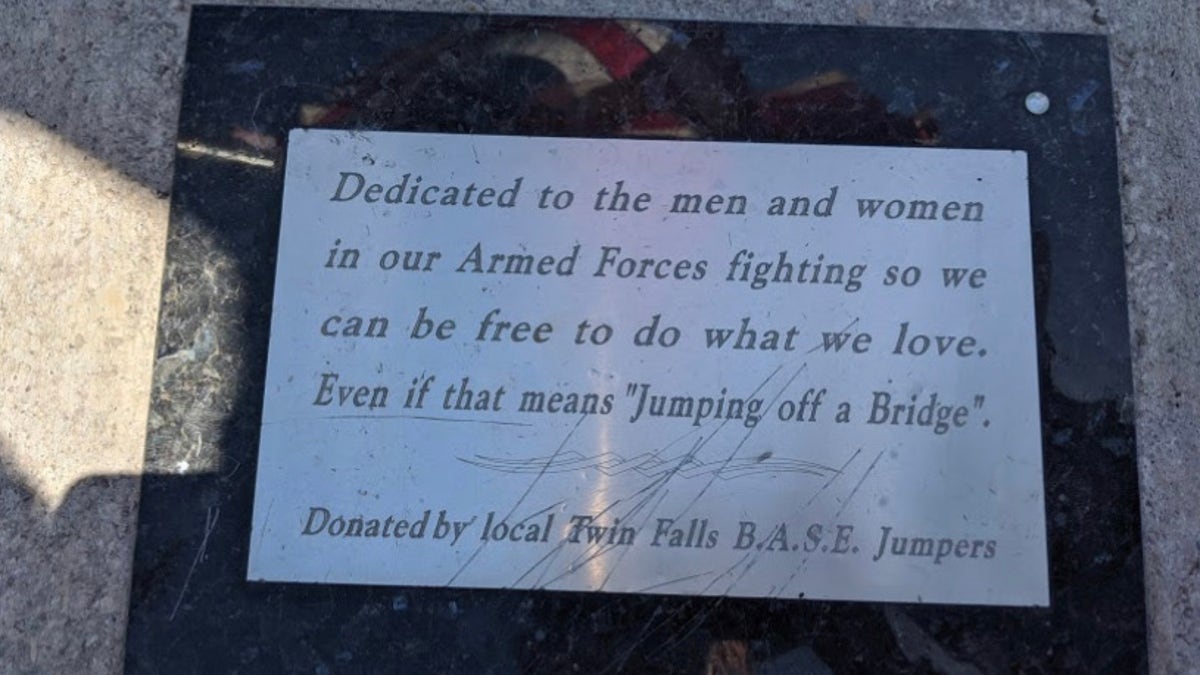All day and well into the night, dozens of people — young and old from all corners of the country — thrust themselves off the 500-foot Perrine Memorial Bridge in Twin Falls, Idaho.
They fall into the abyss before a flare of color bursts above them, and every time, it's a jolt of relief when the parachute emerges. Unlike skydiving, there is no reserve chute to pull, and the lower one leaps from, the more dangerous it is, given how little time there is to guarantee deployment. At the Idaho hotspot, most land on the strip of green earth by the side of the Snake River, some gently glide into the water.
FLORIDA'S WEEKI WACHEE, KNOWN FOR ITS MERMAIDS, DISSOLVES 54 YEARS AFTER CREATION
Welcome to the world of BASE, an acronym for building, antenna, span and earth, which describes the four types of fixed platforms its devotees jump from.
“What drew me to it was just the feeling of being up in the air,” Sean Chuma, an Idaho resident who runs Elite Base Jump Training and has completed more than 6,700 jumps worldwide, told Fox News. “None of us have a death wish. We are just trying to have a lot of fun, and we’re passionate about what we do.”

“What drew me to it was just the feeling of being up in the air,” Sean Chuma, an Idaho resident who runs Elite Base Jump Training and has completed more than 6,700 jumps worldwide. (Hollie McKay/Fox News)
But some jumpers “go in” — meaning that something went wrong and they didn’t make it. After all, it is officially the most extreme of the extreme sports, and the most dangerous activity in the world, with a 1 in 2,300 chance of dying, according to U.K-based health journal Bandolier. By contrast, hang gliding comes with a 1 in 116,000 risk, and skydiving comes in at 1 in 101,083.
BASE JUMPER RESCUED FROM THAI CLIFF AFTER PARACHUTE GETS CAUGHT, LEAVES HIM DANGLING FOR HOURS
Almost 400 BASE jumpers — many at the top of their game — have lost their lives over the past four decades. Nonetheless, it is an ever-growing community, one that swelled during and since the stringent coronavirus lockdown across much of the country. This group of adult superheros convene around Twin Falls, where the Perrine Bridge — made famous by stuntman Evil Knievel in the 1970s — is the only place in the United States where BASE jumping is legal year-round.
It is also one of the few places in the world that offers TANDEM jumps, including with Chuma, for those who want to experience the sensation without the time or means to pour into countless skydives.
“The locals around Perrine have seen a positive impact. It drives tourism, people fly in from all over the world bringing money to the economy, eating at the restaurants, supporting the businesses,” said Jeb Corliss, who stands alongside Chuma as one of the few jumpers to make a living from his adventurous ways, bringing the sport to international audiences with miraculous vaults and brushes with death caught live on camera.
“Every year, people die at ski resorts, but those resorts remain open because there's something to letting people make their own decisions about their lives," Corliss said.

Jeb Corliss is one of the few jumpers to make a living from his adventurous ways, having brought the sport to international audiences with miraculous vaults and brushes with death caught live on camera. (Jeb Corliss)
Even during the protracted coronavirus lockdown, BASE jumpers across the country descended into the small Idaho city and were permitted to continue their jumps, making minor modifications such as adhering to social distancing guidelines and avoiding packing parachutes on the busy bridge to minimize their chances of congregating together as a group.

In the storied "drop zone" by the Perrine Bridge in Twin Falls stands an American Flag and a plaque in honor of U.S. troops. (Hollie McKay/Fox News)
In the storied "drop zone" stands an American flag and a plaque in honor of U.S. troops.
“Dedicated to the men and women in our Armed Forces fighting so we can be free to do what we love. Even if that means ‘Jumping off a bridge,’” reads the plaque. “Donated by local Twin Falls BASE Jumpers.”
And for some veterans, BASE jumping is the closest sensation to combat — an unadulterated feeling of internal flight, confronting the unknown, finding faith in something larger than oneself, and being fully aware of every elastic second rushing toward the earth. For others, it was merely a source of healing and pleasure.

Perrine Memorial Bridge in Twin Falls, Idaho, is the only place in the United States where BASE jumping is legal year-round. (Hollie McKay/Fox News)
“I did it because I wanted the adrenalin, I wanted some fun,” observed Sean Stokes, a 46-year-old retired Navy SEAL who was used to hurling himself off anchored structures. “But I’m done with it now, it fulfilled its purpose. And I knew I needed to look for something that had the reward but less of the risk.”
CLICK HERE FOR FOX NEWS' CONTINUING CORONAVIRUS COVERAGE
Certainly, it comes with a laundry list of associated injuries — a conversation with any longtime enthusiast is typically punctuated with tales of broken backs and shattered ankles.
Yet other devotees claim they're not all in it for the adrenaline rush.
John McEvoy, 35, got into the BASE world in 2013 and hasn’t left. For him, the attraction to the sport is being a part of something mostly unregulated by massive sports arenas or government mandates.
“I used to sneak around and climb up on buildings as a kid, so there was always something ingrained in me. BASE jumping has little to no regulations and rules, so it does attract a certain type of person that might be considered an adrenalin junkie,” he said. “But it also draws in a lot of people who are very calculated and cautious, like pilots and engineers. People more obsessed with the human flight aspect.”
EX-NASA WINGSUIT SCIENTIST DIES DURING BASE JUMP IN SAUDI ARABIA
And for Sequoia Schmidt, 29, who runs a book publishing firm in Texas and spends much of her time traversing the globe as a mountain climber, there is a particular drive to shatter the glass ceiling in a traditionally male-dominated sport and a humility that comes from relinquishing one’s power to forces of nature and personal responsibility.
“Originally, I told myself I would never get into BASE. … It was far too dangerous. But [after a lot of sky-diving] my curiosity was raised, and I fell in love with it,” she noted. “The feeling for me when I step off an object is releasing into the unknown, taking a leap of faith, having trust in myself and in the world, that whatever comes my way, I will be able to fix it.”
CLICK HERE TO SIGN UP FOR OUR LIFESTYLE NEWSLETTER
Despite the controversy that often erupts when a life is lost, the tight-knit BASE community feels it isn’t one that needs additional regulations.
“BASE jumpers do a really good job of self-regulating,” Schmidt explained. “[We] embrace new jumpers and encourage them to go to courses and really learn the safety and the history of BASE jumping.”

Sequoia Schmidt, 29 ahead of a BASE jump in Utah (Sequoia Schmidt)
Corliss concurred.
“It can’t be regulated; that is pretty impossible. You just need a parachute, and there is really no other way to stop it," he said. "These are people who jump off buildings for fun, so they probably aren’t the type to care what you think,” he explained. “We are a unique breed of human (motivated) by making decisions about how one wants to live their own life.”

In this image released by the Phattalung Rescue Organization, a base jumper is rescued after his parachute was caught on a rock's edge, Monday, Jan. 13, 2020, in Phattalung, Thailand. An Austrian base jumper, Johannes Grasser, 28, was rescued in southern the Thai province after being stuck on a near vertical cliff for hours when his parachute caught a rock’s edge, almost 200 meters (656 feet) above the around. (Phattalung Rescue Organization via AP)
There is, of course, a more psychological motivator. If one can conquer a daring jump and do things most would deem impossible, almost any other anxieties of life pale in comparison.
“A lot of what it's about is training fear. How much can I take before my mind cracks? You train that fear response, and you start desensitizing that fear response,” Corliss asserted. “I am probably more scared now of what I do than when I first started. I don’t enjoy the sensation of fear or the adrenalin rush. Where I get fulfillment is in accomplishing a difficult task.”

Almost 400 BASE jumpers – many of them at the top of their game – have lost their lives over the past four decades (Hollie McKay/Fox News)
CLICK HERE FOR THE FOX NEWS APP
And it's certainly not an activity for the faint of heart. It is – perhaps ironically – for the lovers of life.
“You have to do a lot of skydives before you start BASE training; it really is a precision sport. You have to do things right because there are no mistakes allowed,” Chuma added. “We do understand that there are risks in our sport, so we just try to live every day knowing we need to appreciate and really take advantage of the moment.”

